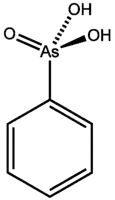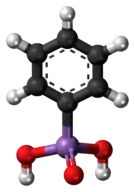| |||
| Names | |||
|---|---|---|---|
| Preferred IUPAC name
Phenylarsonic acid | |||
| Other names
Benzenearsonic acid | |||
| Identifiers | |||
3D model (JSmol) |
|||
| Abbreviations | PAA | ||
| 2935741 | |||
| ChEBI | |||
| ChEMBL | |||
| ChemSpider | |||
| ECHA InfoCard | 100.002.393 | ||
| EC Number |
| ||
| 131185 | |||
| MeSH | Benzenearsonic+acid | ||
PubChem CID |
|||
| RTECS number |
| ||
| UNII | |||
| UN number | 1557 | ||
CompTox Dashboard (EPA) |
|||
| |||
| |||
| Properties | |||
| C6H7AsO3 | |||
| Molar mass | 202.041 g·mol−1 | ||
| Appearance | Colourless solid | ||
| Density | 1.76 g cm−3 | ||
| Melting point | 154 to 158 °C (309 to 316 °F; 427 to 431 K) | ||
| low | |||
| Hazards | |||
| Occupational safety and health (OHS/OSH): | |||
Main hazards |
Toxic | ||
Except where otherwise noted, data are given for materials in their standard state (at 25 °C [77 °F], 100 kPa).
Infobox references | |||
Phenylarsonic acid is the chemical compound with the formula C6H5AsO(OH)2, commonly abbreviated PhAsO3H2. This colourless solid is an organic derivative of arsenic acid, AsO(OH)3, where one OH group has been replaced by a phenyl group. The compound is a buffering agent and a precursor to other organoarsenic compounds, some of which are used in animal nutrition, e.g. 4-hydroxy-3-nitrobenzenearsonic acid.
Preparation and structure
PhAsO3H2 can be prepared in several routes, but a common one entails treatment of phenyl diazonium salts with sodium arsenite (prepared from arsenious acid and base) in the presence of a copper(II) catalyst.[1]
- C
6H
5N+
2 + NaAsO3H2 → C6H5AsO3H2 + Na+ + N2
Related derivatives are prepared similarly.[2] It was first prepared by Michaelis and Loenser.[3][4][5] X-ray crystallography indicates that the molecules are connected by hydrogen-bonds consistent with short distance of 2.5 Å separating the oxygen atoms. The arsenic center is tetrahedral.[6]
Related phenylarsonic acids
Several derivatives of phenylarsonic acid have been used as additives for animal feeds. These include 4-hydroxy-3-nitrobenzenearsonic acid (3-NHPAA, or Roxarsone), p-arsanilic acid (p-ASA), 4-nitrophenylarsonic acid (4-NPAA), and p-ureidophenylarsonic acid (p-UPAA).
References
- ↑ Bullard, R. H.; Dickey, J. B. "Phenylarsonic Acid" Organic Syntheses, Collected Volume 2, pages 494 (1943). http://www.orgsyn.org/orgsyn/pdfs/CV2P0494.pdf
- ↑ Ruddy, A. W.; Starkey, E. B. "p-Nitrophenylarsonic Acid" Organic Syntheses, Collected Volume 3, pp. 665 (1955). "Archived copy" (PDF). Archived from the original (PDF) on 2007-09-30. Retrieved 2007-04-19.
{{cite web}}: CS1 maint: archived copy as title (link) - ↑ A. Michaelis; H. Loesner (1877). "Ueber nitrirte Phenylarsenverbindungen". Berichte der Deutschen Chemischen Gesellschaft. 27: 263–272. doi:10.1002/cber.18940270151.
- ↑ A. Michaelis (1875). "Ueber aromatische Arsenverbindungen". Berichte der Deutschen Chemischen Gesellschaft. 8 (2): 1316–1317. doi:10.1002/cber.187500802125.
- ↑ A. Michaelis; W. La Coste; A. Michaelis (1880). "Ueber die Verbindungen der Elemente der Stickstoffgruppe mit den Radicalen der aromatischen Reihe. Dritte Abhandlung: Ueber aromatische Arsenverbindungen". Annalen der Chemie. 201 (2–3): 184–261. doi:10.1002/jlac.18802010204.
- ↑ Struchkov, Yu. T. "Crystal and molecular structure of phenylarsonic acid" Russian Chemical Bulletin 1960, Volume 9, 1829-1833. doi:10.1007/BF00907739

